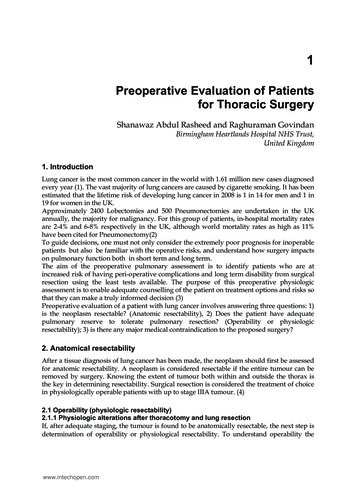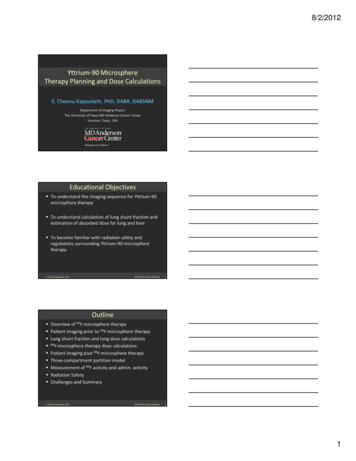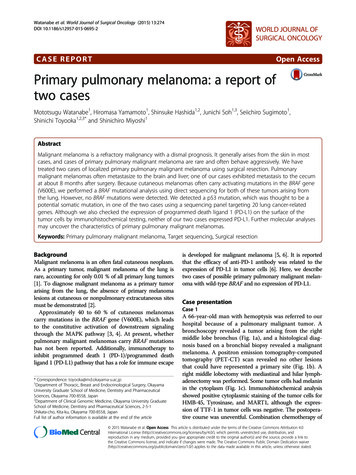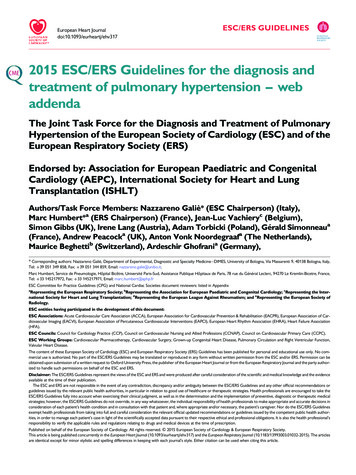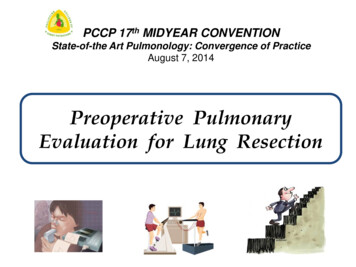
Transcription
PCCP 17th MIDYEAR CONVENTIONState-of-the Art Pulmonology: Convergence of PracticeAugust 7, 2014Preoperative PulmonaryEvaluation for Lung Resection
Outline of Discussion Objectives of preoperative pulmonaryevaluation of patients for surgical resectionUse of predicted postoperative pulmonaryfunction parameters to identify patients atincreased risk for complications after lungresectionPrediction of postoperative pulmonary functionby technique of simple calculation and use oflung perfusion scanAlgorithm for preoperative evaluation of patientsfor lung resection
Reduction of Pulmonary Function after ResectionAcross various studies, postoperative pulmonary functionvalues were assessed at various time intervals afterlobectomy or pneumonectomy: FEV1:84% - 91% of preoperative values for lobectomy,64% - 66% for pneumonectomyDLCO :89% - 96% of preoperative values after lobectomy72% - 80% after pneumonectomy.VO2 max:87% - 100% of preoperative values after lobectomy71% - 89% after pneumonectomy.P. Mazzone. Preoperative evaluation of the lung resection candidate. Cleveland ClinicJournal of Medicine May 2012; Vol 79, e-S17-22
Why do we do preoperativepulmonary evaluation? Physiologic changes in the respiratorysystem occur in all patients undergoingsurgical/anesthetic procedures. These changes may lead tocomplications, mortality and/or morbidity.
Postoperative Complications(Within 30 days of surgery) Acute CO2 retention (PaCO2 45 mm Hg)Prolonged mechanical ventilation ( 48 h)Infections (bronchitis & pneumonia)Atelectasis (necessitating bronchoscopy)BronchospasmExacerbation of the underlying chronic lung diseasePulmonary embolismSymptomatic cardiac arrhythmiasMyocardial infarctionDeathC. Wyser et al. Prospective Evaluation of an Algorithm for the Functional Assessment of Lung Resection Candidates.Am J Respir Crit Care Med 1999;159:1450–1456.F. Grubisic-Cabo et al., Preoperative Pulmonary Evaluation for Pulmonary and Extrapulmonary Operations.Acta Clin Croat. Vol. 42 No. 3, 2003; 237-240
Preoperative EvaluationThe purpose of preoperative evaluation is not to“CLEAR” patients for elective operations butrather to EVALUATE and, if necessary, toIMPLEMENT measures to prepare high riskpatients for the operation.F. Cabo etal., Preoperative Pulmonary Evaliuation for Pulmonary andExtrapulmonary Operations. Acta Clin Crotia 2003F. Grubisic-Cabo et al., Preoperative Pulmonary Evaluation for Pulmonary and ExtrapulmonaryOperations. Acta Clin Croat. Vol. 42 No. 3, 2003; 237-240
Objectives of PreoperativePulmonary Evaluation RISK ASSESSMENT – to identifypatients who are at increased risk ofrespiratory morbidity and mortality RISK REDUCTION – to institutecorrective and preventive measuresto minimize the risk of respiratorymorbidity and mortality
Preoperative Evaluation for LungResection SurgeryWho should be evaluated?The general answer .All patients undergoing lung resectionsurgery, irrespective of age or extentof the lesion.FBut unlike general surgery, preoperative evaluationof patients scheduled for lung resection, requiresspirometry testing and, if necessary, cardiopulmonaryexercise testing (CPET).
Current International GuidelinesAmerican College of Chest Physicians(ACCP) - 3rd Edition, 2013British Thoracic Society (BTS) /Society for Cardiothoracic Surgery inGreat Britain and Ireland - 2010European Respiratory Society (ERS) /European Society of Thoracic Surgery(ESTS) - 2009
CASEZ. B., 82-year-old maleformer 40 pack yearssmokerCXR RUL massFNAB Squamouscell carcinoma
Chest CT scan:- 6.5 x 4.2 x 4.5 cm pleural based mass withpunctate calcification & irregular, spiculatedmargins in the apical & posterior segments ofRUL- No enlarged lymph nodes seen.- No pleural effusion seen.- Liver and both adrenal glands appear normal.Other Metastatic Work-ups: NegativeClinical Stage: T2bN0M0 (Stage IIA)Cardiac Evaluation: Low riskManagement Plan: Lung resective surgery
Case : Pulmonary Function TestsSpirometryFEV1/FVCFEV1 (L)FVC (L)RefPrePreMeas % Ref68581.88 1.26672.97 2.1873DiffusionDLCODL/VAVA LitersRef4.1Post Post%Meas % Ref Chg551.276802.30776PreMeas3.01.162.56Pre% Ref72
Role of Pulmonary Function Testing Aim:To determine the risk for respiratorycomplications and mortality based on thepatient’s preoperative lung function andestimated section lung function. FEV1 : predictive of postoperative complications,including death DLCO :predictive of postoperativecomplications, including death, length of hospitalstay and hospital costs
Question 1What will be your next step in thepreoperative assessment?A. Clear patient for RUlobectomy B. Calculate for the percentpredicted FEV1 and DLCOC. Order a lung perfusion scanD. Order CPET
AbbreviationsPPO FEV1%percent predictedpostoperative FEV1PPO DLCO%percent predictedpostoperative diffusingcapacity for carbon monoxidePPO VO2 max%percent predictedpostoperative maximal orpeak oxygen consumptionThe PPO designation is added to indicate that the estimatedparameter refers to the late postoperative period (3-6 monthsafter the surgical procedure).Degani-Costa, et al. Rev Bras Anestesiol. 2014
FEV1 and PPO FEV1 FEV1 and PPO FEV1 associated with increasedrespiratory morbidity & mortality ratesFEV1 an independent predictor of respiratorymorbidity ( OR, 1.1 for every 10% decrease in FEV1 )FEV1 30% 43% morbidity rateFEV1 60% 12 % morbidity rateLicker et al. (Ann Thorac Surg . 2006 ) confirmedthat the best cutoff value of FEV1 for predictingrespiratory complications was 60%.ACCP Evidence-Based CPG (3rd Edition) 2013
Preoperative FEV1 Data from 2,000 patients in 3 large series in the1970s :Mortality rate of 5% if –- Preoperative FEV1 2 L for a pneumonectomy- Preoperative FEV1 1.5 L for a lobectomy FEV1 80% predicted accepted indicates that thepatient should be considered suitable to undergopneumonectomy without further evaluation.ACCP CPG (2nd Edition) 2007BTS CPG 2001
Preoperative FEV1 If there is no evidence of either undue dyspneaon exertion or interstitial lung disease and:FEV1 80% predicted or 2 L suitable forresection including pneumonectomy withoutfurther physiologic evaluation.FEV1 is 1.5 L suitable for a lobectomywithout further physiologic evaluation.ACCP CPG (2nd Edition ) 2007
Absolute Values vs Percent Predicted Absolute values (preoperative FEV1 and PPO FEV1)did not predict surgical outcome defined by 30-daymortality and post-operative respiratory failureIn contrast, all values (preoperative FEV1 and DLCO,PPO FEV1 and PPO DLCO) expressed as a percentageof the normal predicted value) correlated significantly withboth complicated post-operative course and poor surgicaloutcome.Recommendation: Percentage predicted rather thanabsolute lung function values be used in assessingpatients for lung cancer surgery future guidelines shouldadopt percentage predicted rather than absolute values.T. Win et al. Relationship between pulmonary function and lung cancer surgical outcome.Eur Respir J 2005; 25: 594–599
DLCO and PPO DLCO Reduced PPO DLCO strongly associated withthe risk of post-resection pulmonary complications& mortality% PPO DLCO higher correlation withpostoperative deaths than the % PPO FEV1% PPO DLCO 60% was associated with a25% mortality & 40% pulmonary morbidity(Ferguson et al) – confirmed by other authorsACCP Evidence-Based CPG (3rd Edition) 2013
Correlation between FEV1 and DLCO Correlation between FEV1 and DLCO isconsistently poorReduced PPO DLCO is a predictor ofcardiopulmonary complications and mortalityeven in patients with an otherwise normal FEV1More than 40% of patients with an FEV1 80%may have a DLCO 80% ; 7% of them mayhave a PPO DLCO 40%ACCP CPG (3rd Edition) 2013
Recommendation: Lung FunctionALL patients for lungresectionMeasure both FEV1 and DLCOandCalculate both PPO FEV1 andPPO DLCOACCP CPG (3rd Edition) 2013
Recommendation: FEV1 and DLCOACCP (2013)Both PPO FEV1 andPPO DLCO 60% *ERS (2009)Both FEV1 and DLCO80%No further testsrecommendedLOW RISK* PPO FEV1 or PPO DLCO cut off values of 60% predicted values has beenchosen based on indirect evidences and expert consensus opinion.
Estimation of PPO FEV1 and PPO DLCOAnatomic Method (Segment Counting): only forlobectomyPPO FEV1 preoperative FEV1 * x (1 – y/z)* the best measured postbronchodilator valuePPO DLCO preoperative DLCO x (1 – y/z)y the number of functional or unobstructedlung segments to be removedz the total number of functional segmentsACCP CPG (3rd Edition) 2013
PPO FEV1 preop FEV1 x (1 – number offunctional or unobstructed lungsegments to be resected /total number of functional segments)PPO DLCO preop DLCO x (1 – number offunctional or unobstructed lunglung segments to be resected /total number of functional segments)* Only segments not totally obstructed should be taken intoaccount: evaluated by image techniques and/or bronchoscopy
PPO FEV1 and PPO DLCO expressed as apercentage of predicted to calculate % PPO FEV1and DLCO:computed PPO FEV1% PPO FEV1 predicted normal FEV1X 100computed PPO DLCO% PPO DLCO X 100predicted normal DLCO
Number of Lung Segments10932554
Case : FEV1 and DLCORefPrePre Post Post%Meas % Ref Meas % Ref ChgFEV1 (L)1.881.2667DLCO4.13.0721.27680
Case : Calculation of PPO FEV1 %Anatomic Method (for RU lobectomy):PPO FEV1 preoperative FEV1 x (1 - y/z) 1.27 x (1 – 3/19) 1.27 x (1 – 0.158) 1.27 x 0.842 1.069 1.07 LPPO FEV1 % [PPO FEV1 / pred FEV1] x 100 [ 1.07 / 1.88 ] x 100 0.569 x 100 56.9% 57%
Case : Calculation of PPO DLCO %Anatomic Method (for RU lobectomy):PPO DLCO preoperative DLCO x (1 - y/z) 3.0 x (1 – 3/19) 3.0 x (1 – 0.158) 3.0 x 0.842 2.526 2.53PPO DLCO % [PPO DLCO / predicted DLCO]x 100 [ 2.53 / 4.1 ] x 100 0.617 x 100 61.7 % 62%
Case : PPO FEV1 % and PPO DLCO%Anatomic Method (for RU Lobectomy)PPO FEV1 % 57 %PPO DLCO % 62 %
Question 2Based on calculated PPO FEV1 % and PPODLCO% by anatomic method, what is yourassessment ?A. Assess as low risk for RU lobectomyB. Assess as moderate risk for RUlobectomyC. Assess as high risk for RU lobectomyD. Needs further assessment; Order aperfusion scan
Quantitative Radionuclide Scanning Anatomic (segment counting) method: recommendedonly to estimate lung function after a lobectomyTo estimate the PPO FEV1 and DLCO afterpneumonectomy A quantitative radionuclideperfusion scan is performed to measure the fractionof total perfusion for the resected lung.Either ventilation or perfusion scancan be used to predict PPO lungfunction. Perfusion scan morecommonly used. No additionalbenefit in performing both.Beckles et al, physiologic evaluation of patients with lung cancer being considered for resectional sugery. Chest 2003Guidelines on the radical management of patients with lung cancer. British Thoracic Society and the Society for CardiothoracicSurgery in Great Britain and Ireland. Thorax 2010;65
Estimation of PPO FEV1 and PPO DLCOPerfusion Method: to calculate predictedpostoperative values of FEV1 or DLCO forpneumonectomy PPO FEV1 preoperative FEV1 * x (1 – fractionof total perfusion for the resected lung)* the best measured postbronchodilator values PPO DLCO preoperative DLCO x (1 –fraction of total perfusion for the resectedlung)PPO FEV1 and PPO DLCO expressed as a percentageof predicted to calculate % PPO FEV1 and DLCO
Case: Lung Perfusion ScanRight LungLeft LungUpper Zone9.1 %13.5 %Middle Zone25.3 %29.2 %Lower Zone12.6 %10.3 %47 %53 %Total :
Case : Calculation of PPO FEV1Perfusion Method (for RU lobectomy):PPO FEV1 preoperative FEV1 x (1 - fractionof total perfusion for the resectedlung) 1.27 x (1 – 9.1 %) 1.27 x (1 – 0.091) 1.27 x (0.909) 1.15443 1.15 LPPO FEV1 % [PPO FEV1 / pred FEV1] x 100 [ 1.15 / 1.88 ] x 100 0.612 x 100 61.2 %
Case : Calculation of PPO DLCOPerfusion Method (for RU lobectomy):PPO DLCO preoperative DLCO x (1 - fractionof total perfusion for the resectedlung) 3.0 x (1 – 9.1 %) 3.0 x (1 – 0.091) 3.0 x 0.909 2.727 2.73PPO DLCO % [PPO DLCO / pred DLCO] x100 [ 2.73/ 4.1 ] x 100 0.666 x 100 66.6 %
Case : Calculation of PPO FEV1Perfusion Method (for Right Pneumonectomy):PPO FEV1 preoperative FEV1 x (1 - fractionof total perfusion for the resectedlung) 1.27 x (1 – 47 %) 1.27 x (1 – 0.47) 1.27 x (0.53) 0.67PPO FEV1 % [PPO FEV1 / pred FEV1] x 100 [ 0.67 / 1.88 ] x 100 0.356 x 100 35.6 %
Case : Calculation of PPO DLCOPerfusion Method (for Right Pneumonectomy ):PPO DLCO preoperative DLCO x (1 - fractionof total perfusion for the resectedlung) 3.0 x (1 – 47 %) 3.0 x (1 – 0.47 ) 3.0 x 0.53 1.59PPO DLCO % [PPO DLCO / pred DLCO] x100 [ 1.59 / 4.1 ] x 100 0.388 x 100 38.8 %
Case : Summary of PPO FEV1% andPPO DLCO%Anatomic Method : RU LobectomyPPO FEV1 % 57 %PPO DLCO % 62 %Perfusion Method : RU LobectomyPPO FEV1 % 61.2 %PPO DLCO % 66.6 %Perfusion Method : R PneumonectomyPPO FEV1 % 35.6 %PPO DLCO % 38.8 %
Question 3At this point, what is your risk assessment ofthis patient? A. Low risk for both RU lobectomy andR pneumonectomyB. Moderate risk for both RU lobectomyand R pneumonectomyC. High risk for both RU lobectomy andR pneumonectomyD. Low risk for RU lobectomy, but needsfurther test for possible Rpneumonectomy
Lung Cancer SurgeryThe objective is to ascertain that after surgical resection ofthe lung , there will be sufficient pulmonary reserve tokeep the patient comfortable and will not become arespiratory cripple.One should always evaluate the patient to determinewhether he could withstand a pneumonectomy , even ifit is believed preoperatively that all that is needed isa lobectomy or a wedge resection.If during the exploratory thoracotomy the tumorcrosses the major fissure or extends to the hilumand a pneumonectomy is needed, the opportunity foran extensive physiologic evaluation is generally toolate.F. Grubisic-Cabo et al., Preoperative Pulmonary Evaluation for Pulmonary and Extrapulmonary Operations.Acta Clin Croat. Vol. 42 No. 3, 2003; 237-240Olsen GN. Pulmonary Physiologic Assessment of Operative Risk. General Thoracic Surgery by Shields,TW. 5th ed. 2000; Chapter 19 : 297-304.
Question 4What additional test will you order tofurther assess risk for pneumonectomy? A.B.C.D.E.6 minute walk testStair climbShuttle walk testCPETAny of the above
Exercise TestsAim of exercise testing: to stress the whole cardiopulmonary / systemic oxygen delivery systems and estimatethe physiological reserve that may be available after surgery.Meta-analysis by Benzo et al. (Respir Med 2007) :- has shown that exercise capacity, expressed asVO2 peak is lower in patients that develop post-operativecardiorespiratory complications after lung resection.Besides early postoperative outcome, performance onexercise tests is also a better predictor of long-term exercisecapacity than conventional pre-operative PFTs.(Bolliger et al. Eur Respir J 1996)Nevertheless, exercise tests are usually recommended onlyin selected cases (unfit or reduced FEV1 and/or DL,CO)ERS/ESTS clinical guidelines on fitness for radical therapy in lung cancer patients (surgery andchemo- radiotherapy). Eur Respir J 2009; 34: 17–41
Cardiopulmonary Exercise testing (CPET) CPET: a sophisticated physiologic testing technique thatprovides an objective evaluation of functional capacity ofboth the lungs & heart and is known as a safe testprocedureInability to perform a preoperativeexercise test indication of limitedaerobic capacityRecommended by previous ¤t guidelines as the next stepin the preoperative risk-assessmentprocess in those patients withcompromised pulmonary function.ACCP Evidence-Based CPG 2013Tilburg et al. Eur Respir J 2009; 33
Cardiopulmonary Exercise Testing StandardizedCPET using VO2 max has beenshown to predict postoperative complications,including perioperative and long-term morbidityand mortality ACCP: CPET indicated- positive high-risk cardiac evaluation- either FEV1 or DLCO 30% or- SCT 22 m or SWT 400 m ERS: CPET recommended when FEV1 orDLCO 80%
Cardiopulmonary Exercise TestingThe risk for perioperative complications has been reportedto be higher with lower measured VO2max : VO2 max 20 ml/kg/min or 75% predicted::- can safely safely undergo the planned resection(up to pneumonectomy)VO2 max between 10-15 ml/kg/min or between35%- 75% predicted:- indicates an increased risk of perioperative deathcompared with higher values of VO2 max.VO2 max of 10 ml/kg/min or 35% predicted:- very high risk for postoperative death- generally regarded as a contraindication to majoranatomic resectionsACCP Evidence-Based CPG (3rd Edition) 2013
Low Technology Exercise TestsSTAIR CLIMBING TEST (SCT) Can used be as a first-line functionalscreening test to select those patients thatcan undergo safely to operation (height ofascent 22 m)Limitation of test : lack of standardization the duration of stair climbing, the speed ofascent, the number of steps per flight, theheight of each step, and the criteria forstopping the test have varied from study tostudy.ERS/ESTS CPG 2009ACCP Evidence-Based CPG (2rd Edition) 2007
Low Technology Exercise Tests SHUTTLE WALK TEST (SWT)Procedure :- Requires the patient to walk back10 mand forth between 2 markers set10 m apart- Walking speed is increased each minute in a gradedfashion and paced by an audio signal- End of test : when patient is too breathless tomaintain speedInability to complete 25 shuttles (250 m) on 2 occasionssuggests a VO2 max of 10 ml/kg/minM. Beckles et al. CHEST 2003;123ACCP CPG (2nd Edition) 2007
Low Technology Exercise TestsSIX MINUTE WALK TEST (SMWT) Procedure measures the distance thatthe patient can quickly walk on a flat,hard surface in a period of 6 minutes.Patients instructed to walk as far aspossible in a period of 6 minutes.Rest during the test is permissible.Interpretation of the distance walkedin 6 min currently not well standardized.Current guidelines: The 6-min walk testshould not be used to select patients for operation.ERS/ESTS CPG 2009
Recommendation: Exercise TestsHigh-riskCardiac evaluationCPETPPO FEV1 orPPO DLCO 30%SCT 22 m orSWT 400mPPO FEV1 and/orPPO DLCOBetween 30%-60%Stair Climb orShuttle Walk TestACCP CPG (3rd Edition) 2013
Recommendation: CPETVO2 max 20mL/kg/minor 75%VO2 max10-20mL/kg/minor 35% - 75%VO2 max 10mL/kg/minor 35%LOWRISKMODERATERISKHIGHRISKACCP CPG (3rd Edition) 2013ERS/ESTS CPG 2009
Estimation of PPO VO2 maxFor Pneumonectomy:PPO VO2 max preoperative VO2 max x(1 – fraction of total perfusion for the lung tobe resected)ERS/ESTS CPG 2009
Physiologic Evaluation Resection AlgorithmACCP Evidence-Based Clinical Practice Guidelines (2013)
Definition of Low Risk Indicates that the patient’sfunctional reserve issufficient to withstand thestress of surgery andperform daily activities in thelate postoperative period The expected risk ofmortality is below 1%. Major anatomic resectionsACCP CPG (3rd Edition) 2013Degani-Costa, et al.Rev Bras Anestesiol. 2014can be safely performed inthis group.
Definition of Moderate Risk Morbidity and mortality rates may vary according to thevalues of split lung functions,exercise tolerance andextent of resection.The benefit of surgery isconsidered to outweigh therisks. RisksACCP CPG (3rd Edition) 2013Degani-Costa, et al.Rev Bras Anestesiol. 2014and benefits of theoperation should bethoroughly discussed withthe patient.
Definition of High Risk Generally considered acontraindication to surgery dueto the high mortality rate ( 10%)after standard major anatomicresections ACCP CPG (3rd Edition) 2013Degani-Costa, et al.Rev Bras Anestesiol. 2014Considerable risk of severecardiopulmonary morbidity andresidual functional loss isexpected.Patients should be counseledabout alternative surgical (minorresections or minimally invasivesurgery) or nonsurgical options.
Proposed Algorithm for Preoperative Risk Assessment for Lung Resection
All patients being considered for lung resectionshould undergo preoperative physiologicevaluation. Pulmonary function testing using spirometry(FEV1), DLCO and VO2 max help predict the riskof post-operative complications and mortality. Predicting postoperative lung function using theproportion of lung segments to be resected,perfusion scanning, or other methods is importantfor assessing surgical risk. Current international guidelines providealgorithms for preoperative risk assessment.
Reduction of Pulmonary Function after Resection P. Mazzone. Preoperative evaluation of the lung resection candidate. Cleveland Clinic Journal of Medicine May 2012; Vol 79, e-S17-22
